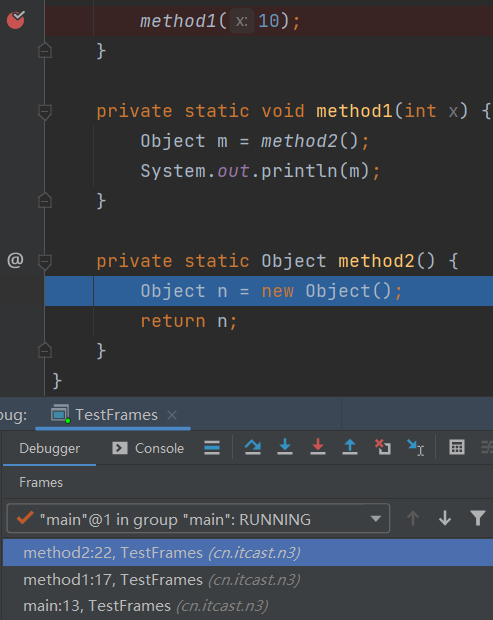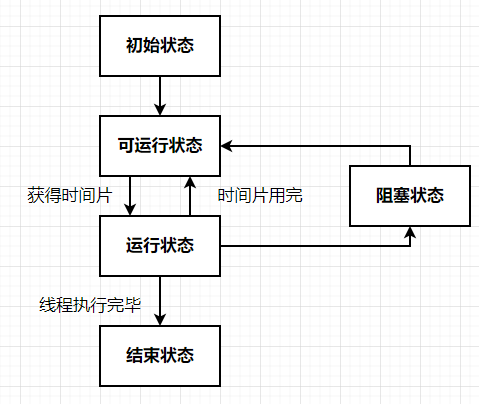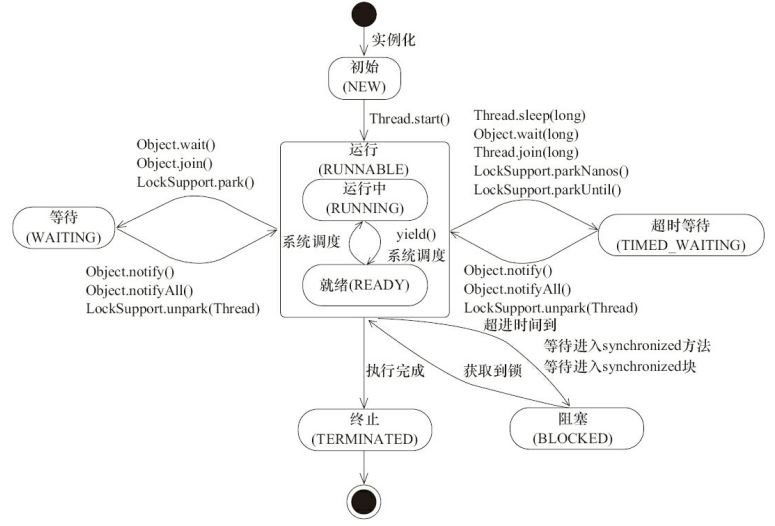JUC进程与线程学习
夸父号 人气:0进程与线程
进程
- 程序由指令和数据组成,但这些指令要运行,数据要读写,就必须将指令加载至 CPU,数据加载至内存。在指令运行过程中还需要用到磁盘、网络等设备。进程就是用来加载指令、管理内存、管理 IO 的
- 当一个程序被运行,从磁盘加载这个程序的代码至内存,这时就开启了一个进程。
- 进程就可以视为程序的一个实例。大部分程序可以同时运行多个实例进程(例如记事本、画图、浏览器等),也有的程序只能启动一个实例进程(例如网易云音乐、360 安全卫士等)
线程
线程是主要负责运行指令,进程是主要管加载指令。
一个进程之内可以分为一到多个线程。
一个线程就是一个指令流,将指令流中的一条条指令以一定的顺序交给 CPU 执行
Java 中,线程作为最小调度单位,进程作为资源分配的最小单位。 在 windows 中进程是不活动的,只是作为线程的容器
同步异步
- 需要等待结果返回,才能继续运行就是同步
- 不需要等待结果返回,就能继续运行就是异步
串行并行执行时间
使用多核cpu并行执行可以明显的提高执行效率
- 串行执行时间 = 各个线程时间累加和 + 汇总时间
- 并行执行时间 = 最慢的线程时间 + 汇总时间
注意:单核依然是并发的思想(即:cpu轮流去执行线程,微观上仍旧是串行),使用单核的多线程可能会比使用单核的单线程慢,这是因为多线程上下文切换反而浪费了时间。
创建和运行线程
1.使用 Thread
public static void main(String[] args) {
// 创建线程对象
Thread t = new Thread("线程1") {
public void run() {
// 要执行的任务
log.debug("线程1被启动了");
}
};
// 启动线程
t.start();
log.debug("测试");
}
2.使用 Runnable 配合 Thread
public static void main(String[] args) {
Runnable runnable = new Runnable() {
public void run() {
// 要执行的任务
log.debug("线程1被启动了");
}
};
// 创建线程对象
Thread t = new Thread(runnable);
t.setName("线程1");
// 启动线程
t.start();
log.debug("测试");
}
这里的Runnable是一个接口,接口中只有一个抽象方法,由我们来提供实现,实现中包含线程的代码就可以了。
@FunctionalInterface
public interface Runnable {
/**
* When an object implementing interface <code>Runnable</code> is used
* to create a thread, starting the thread causes the object's
* <code>run</code> method to be called in that separately executing
* thread.
* <p>
* The general contract of the method <code>run</code> is that it may
* take any action whatsoever.
*
* @see java.lang.Thread#run()
*/
public abstract void run();
}
Thread 与 Runnable 的关系原理分析
方法1原理分析
方法2是使用runnable对象,当成参数传给Thread构造方法,其中又调用了init方法,下面是Thread构造方法的源码
public Thread(Runnable target) {
init(null, target, "Thread-" + nextThreadNum(), 0);
}
继续跟踪查看runnable对象传到哪里去了,可以看到又传给了另一个重载的init,如下
private void init(ThreadGroup g, Runnable target, String name, long stackSize) { init(g, target, name, stackSize, null, true); }private void init(ThreadGroup g, Runnable target, String name,
long stackSize) {
init(g, target, name, stackSize, null, true);
}
再次跟踪可以看到是把runnable对象传给了一个thread的一个成员变量
//省略部分代码 this.target = target;
那么这个成员变量在哪里在使用了呢,经过查找可以发现是在run方法里面,只不过Thread发现有runnable对象就会先采用runnable的run方法。
@Override
public void run() {
if (target != null) {
target.run();
}
}
方法2原理分析
通过创建一个子类去重写Thread类的run方法,这样就不会执行父类的run方法。
1.用 Runnable 更容易与线程池等高级 API 配合
2.用 Runnable 让任务类脱离了 Thread 继承体系,更灵活
方法3 FutureTask配合Thread创建线程

Future接口中含有get方法来返回结果的
//省略部分代码
V get() throws InterruptedException, ExecutionException;
V get(long timeout, TimeUnit unit)
throws InterruptedException, ExecutionException, TimeoutException;
而runnable本身是没有返回结果的,runnable不能将结果传给其他线程。
public interface Runnable {
public abstract void run();
}
要注意到FutureTask也实现了Runnable接口,也可以传给Thread的有参构造里面。
创建线程的代码
public static void main(String[] args) throws ExecutionException, InterruptedException {
// 创建任务对象
FutureTask<Integer> task3 = new FutureTask<>(new Callable<Integer>() {
@Override
public Integer call() throws Exception {
log.debug("线程1被执行了");
return 666;
}
});
// 参数1 是任务对象; 参数2 是线程名字,推荐
new Thread(task3, "线程1").start();
// 主线程阻塞,同步等待 task 执行完毕的结果
Integer result = task3.get();
log.debug("结果是:{}", result);
}
查看进程
- 任务管理器可以查看进程和线程数,也可以用来杀死进程,也可以在控制台使用
tasklist查看进程taskkill杀死进程 - jconsole 远程监控配置来查看
线程运行原理
JVM 中由堆、栈、方法区所组成,其中栈就是给线程使用的。

方法调用时,就会对该方法产生一个栈帧,方法的局部变量都会在栈帧中存储。栈是后进先出,当method2执行完就会回收,在执行完同时会记录返回地址,然后在method1中继续执行。
线程之间的栈帧是相互独立的,之间互不干扰。
线程上下文切换
当上下文切换时,要保存当前的状态,因为可能是时间片用完了,此时线程还没有结束。Java中对应的就是程序计数器
start与run方法
启动一个线程必须要用start方法,如果直接调用类里面的run方法实际走的是main主线程。
线程start前getState()得到的是NEW
线程start后getState()得到的是RUNNABLE
public static void main(String[] args) {
Thread t1 = new Thread("t1") {
@Override
public void run() {
log.debug("t1被启动");
}
};
System.out.println(t1.getState());
t1.start();
System.out.println(t1.getState());
}
sleep方法
在sleep期间调用getState()方法可以得到TIMED_WAITING
public static void main(String[] args) {
Thread t1 = new Thread("线程1") {
@Override
public void run() {
try {
Thread.sleep(3000);
} catch (InterruptedException e) {
e.printStackTrace();
}
}
};
t1.start();
log.debug("线程1 state: {}", t1.getState());
try {
Thread.sleep(500);
} catch (InterruptedException e) {
e.printStackTrace();
}
log.debug("线程1 state: {}", t1.getState());
}
sleep打断
sleep可以使用interrupt方法打断,打断后会触发InterruptedException异常
public static void main(String[] args) throws InterruptedException {
Thread t1 = new Thread("t1") {
@Override
public void run() {
log.debug("进入睡眠");
try {
Thread.sleep(2000);
} catch (InterruptedException e) {
log.debug("被唤醒");
e.printStackTrace();
}
}
};
t1.start();
Thread.sleep(1000);
log.debug("打断");
t1.interrupt();
}
sleep防止cpu使用100%
在没有利用cpu来计算时,不要让while(true)空转浪费cpu,这时可以使用yield或 sleep 来让出cpu的使用权给其他程序
yield方法会把cpu的使用权让出去,然后调度执行其它线程。线程的调度最终还是依赖的操作系统的调度器。
join方法
该方法会等待线程的结束
static int r = 11;
public static void main(String[] args) throws InterruptedException {
test1();
}
private static void test1() throws InterruptedException {
log.debug("主线程开始");
Thread t1 = new Thread(() -> {
sleep(1);
r = 888;
},"线程1");
t1.start();
// t1.join();
log.debug(String.valueOf(r));
log.debug("主线程线程结束");
}
join没有使用时,返回的是11,若是使用join返回的是888,是主线程在同步等待线程1。
当然还有其他的方法等待
1.sleep方法等待线程1结束
2.利用FutureTask的get方法
join(long n)方法可以传入参数,等待线程运行结束,最多等待 n 毫秒,假如执行时间大于等待的时间,就会不再等待。那么该线程会直接结束吗?答案是不会。
如下代码
public class Test10 {
static int r = 11;
public static void main(String[] args) throws InterruptedException {
test1();
}
private static void test1() throws InterruptedException {
log.debug("主线程开始");
Thread t1 = new Thread(() -> {
sleep(2);
r = 888;
log.debug("线程1结束");
},"线程1");
t1.start();
t1.join(1000);
log.debug(String.valueOf(r));
log.debug("主线程线程结束");
}
}
输出结果,可以看到这里只是主线程不再等待。
16:28:53.360 c.Test10 [main] - 主线程开始
16:28:54.411 c.Test10 [main] - 11
16:28:54.411 c.Test10 [main] - 主线程线程结束
16:28:55.404 c.Test10 [线程1] - 线程1结束
interrupt 方法
interrupt可以用来打断处于阻塞状态的线程。在打断后,会有一个打断标记(布尔值)会提示是否被打断过,被打断过标记为true否则为false.
但是sleep、wait和join可以来清空打断标记。
代码如下
public static void main(String[] args) throws InterruptedException {
Thread t1 = new Thread(() -> {
log.debug("sleep...");
try {
Thread.sleep(4000);
} catch (InterruptedException e) {
e.printStackTrace();
}
},"t1");
t1.start();
Thread.sleep(1000);
log.debug("interrupt");
t1.interrupt();
log.debug("打断标记:{}", t1.isInterrupted());
}
线程被打断后并不会结束运行,有人就会问了,那我们如何在打断线程后关闭线程呢?答案就是利用打断标记去实现。
可以在线程的死循环之中加入一个判断去实现。
boolean interrupted = Thread.currentThread().isInterrupted();
if(interrupted) {
log.debug("退出循环");
break;
}
守护进程
Java 进程通常需要所有线程都运行结束,才会结束。
但是存在一种守护进程,只要其他非守护进程结束,守护进程就会结束。垃圾回收器就使用的守护进程。
线程的状态
操作系统层面(早期进程的状态)

- 初始状态 在语言层面创建了线程对象,还未与操作系统线程关联
- 可运行状态(就绪状态)指该线程已经被创建(与操作系统线程关联),可以由 CPU 调度执行任务。
- 运行状态 获取了 CPU 时间片运行中的状态
- 调用阻塞api使运行状态转为阻塞状态
- 终止状态 表示线程已经执行完毕
Java API 层面

1、新建状态(New)
Thread t1 = new Thread("t1") {
@Override
public void run() {
log.debug("running...");
}
};
log.debug("t1 state {}", t1.getState());
2、就绪状态(Runnable)与运行状态(Running)
Thread t2 = new Thread("t2") {
@Override
public void run() {
while(true) { // runnable
}
}
};
t2.start();
log.debug("t2 state {}", t2.getState());
3、阻塞状态(Blocked)
用一个线程拿到锁,使得当前线程没拿到锁会出现阻塞状态。
Thread t6 = new Thread("t6") {
@Override
public void run() {
synchronized (TestState.class) { // blocked
try {
Thread.sleep(90000);
} catch (InterruptedException e) {
e.printStackTrace();
}
}
}
};
t6.start();
4、等待状态(Waiting)
等待一个未执行完成的线程
t2.join(); //等待状态
5、超时等待(Time_Waiting)
可以在指定的时间自行返回的。
6、终止状态(TERMINATED)
线程执行完了或者因异常退出了run()方法,该线程结束生命周期。 终止的线程不可再次复生。
总结
本篇文章就到这里了,希望能够给你带来帮助,也希望您能够多多关注的更多内容!
加载全部内容